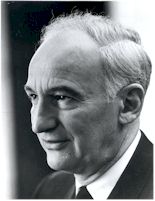- Simon Ramo
Infobox Scientist
name = Simon Ramo
box_width =
image_width =150px
caption = Simon Ramo
birth_date =May 13 ,1913 (age 95)
birth_place =Salt Lake City, Utah
death_date =
death_place =
residence =
citizenship =
nationality = American
ethnicity =
field =physics
work_institutions =
alma_mater =
doctoral_advisor =
doctoral_students =
known_for =Intercontinental ballistic missile (ICBM)
author_abbrev_bot =
author_abbrev_zoo =
influences =
influenced =
prizes =
religion =
footnotes =
Simon Ramo (bornMay 13 ,1913 ) is an American physicist, engineer, and business leader. He led development of microwave and missile technology and is sometimes known as the father of theIntercontinental ballistic missile (ICBM). He has been partly responsible for the creation of two Fortune 500 companies of the 1970s; Ramo-Wooldridge (TRW after 1958) and Bunker-Ramo (now part ofHoneywell ).Ramo was born in
Salt Lake City, Utah , the son ofRussia n and Ukrainian immigrants who ran a small store. He entered theUniversity of Utah at the age of 16, and earned a B.S. in Electrical Engineering. By 1936, at the age of twenty-three, he had earned dual PhD degrees from Caltech inPhysics and Electrical Engineering.From 1936 until 1946 he led electronics research at
General Electric . He became globally recognized as a leader inMicrowave research and headed the development of GE’sElectron microscope . He also published textbooks on Fields and Waves in Modern Radio (1944) and Introduction to Microwaves (1945).In 1946 he returned to
California to become director of research for the electronics department ofHughes Aircraft , and his career became coupled with that ofDean Wooldridge . Together they formed a successful team for many years, with Wooldridge concentrating on investment and general business aspects while Ramo led research, development and engineering. By 1948, Hughes had created its Aerospace Group to work with the newly created U.S. Air Force. Dr. Ramo became a Vice-President and the Group's Director of Operations. Ramo employed his skills in Systems Engineering to allow Hughes to deliver integrated RADAR and aircraft fire-control systems. He developed the air-to-air missile, creating the Falcon missile.By 1953, both Ramo and the Air Force had become increasingly frustrated with management problems at Hughes. Ramo and Wooldridge were particularly concerned when
Howard Hughes avoided their attempts to discuss the problem. In September they jointly resigned, and within a week they formed theRamo-Wooldridge Corporation onSeptember 16 ,1953 .In October 1953 an Assistant Secretary of Defense,
Trevor Gardner , created a committee to consider the future of guided missiles. This Strategic Missile Evaluation Committee (SMEC) was headed byJohn von Neumann and included both Ramo and Wooldridge. In four months, the committee produced their report and recommended that a crash program was needed to developIntercontinental ballistic missile s, and that such a program might enable the United States to overtake Russian developments by 1959-1960.The Ramo-Wooldridge Corp. became the lead contractor for the resulting Air Force program. With Dr. Ramo as the driving scientific and engineering officer, they succeeded. In 1958, an Atlas Rocket delivered a payload 5,000 miles downrange. The Atlas would go on to serve as the launch vehicle for NASA’s
Project Mercury orbital flights, starting withJohn Glenn in Friendship 7. USAF GeneralBernard Schriever , head of the ICBM program, described Ramo as "the architect of the Thor, Atlas, and Titan" rockets.According to a July 30, 2002 article by Peter Pae, Los Angeles Times aerospace staff writer, Ramo’s comments are legendary for capsulizing complex ideas into off-the-cuff witticisms.
During a series of key experiments of ballistic missiles in the 1950s at Cape Canaveral, Florida, at which Ramo and Air Force General Bernard Schriever were observers, test rockets kept blowing up on their launch pads. When one missile rose about 6 inches before toppling over and exploding, Ramo reportedly beamed and said: “Well, Benny, now that we know the thing can fly, all we have to do is improve its range a bit.”
Ramo-Wooldridge merged with Thompson Products to become
TRW , and Simon Ramo became Vice-Chairman. In 1969, when TRW spun off their Space Technology Laboratories division, it becameBunker-Ramo , with Ramo as President, and expanded into the computer and communications technology fields.During his long and successful career, Ramo has received numerous awards and fellowships. He has been honored by the
American Philosophical Society , theInstitute of Electrical and Electronics Engineers (IEEE), theAmerican Physical Society , and theAmerican Academy of Arts and Sciences .Ramo is also a founding member of the
National Academy of Engineering . [http://www.nae.edu/nae/naehome.nsf/weblinks/NAEW-4NHMJ7?OpenDocument]Ramo has also authored dozens of books on topics ranging from science textbooks, corporate and technology management, society's relation to technology, economy, and how to play
tennis .In January 2008, he joined the faculty of the
University of Southern California 'sViterbi School of Engineering as a presidential chair and professor of electrical engineering. [http://www.usc.edu/uscnews/stories/14703.html Legendary Engineer Joins USC Viterbi] , USC News, January 10, 2008.]Ramo lives in
Beverly Hills, California .References
Further reading
*Simon Ramo; "The Business of Science: Winning and Losing in the High-Tech Age; " 1988, Hill & Wang Pub (ISBN 0-8090-3255-4).
*Davis Dyer; "TRW: Pioneering Technology and Innovation since 1900;" 1998, Harvard Business School Press (ISBN 0-87584-606-8).
*Stephen B. Johnson; "The Secret of Apollo: Systems Management in American and European Space Programs;" 2002, The Johns Hopkins University Press (ISBN 0-8018-6898-X).
*G. Harry Stine; "ICBM; " 1991, Orion Books (ISBN 0-517-56768-7).
*Ernest Schwiebert; "A History of the U.S. Air Force Ballistic Missiles; " 1965, Praeger Publishers.External links
* [http://www.ieee.org/web/aboutus/history_center/biography/ramo.html Biographic sketch at IEEE website]
* [http://www.nae.edu/nae/naehome.nsf/weblinks/NAEW-4NHMJ7?OpenDocument List of Founding Members of National Academy of Engineering]
Wikimedia Foundation. 2010.
